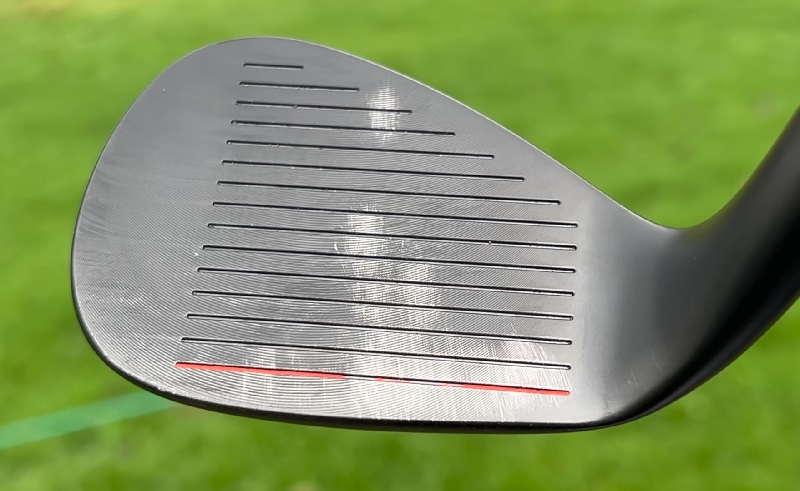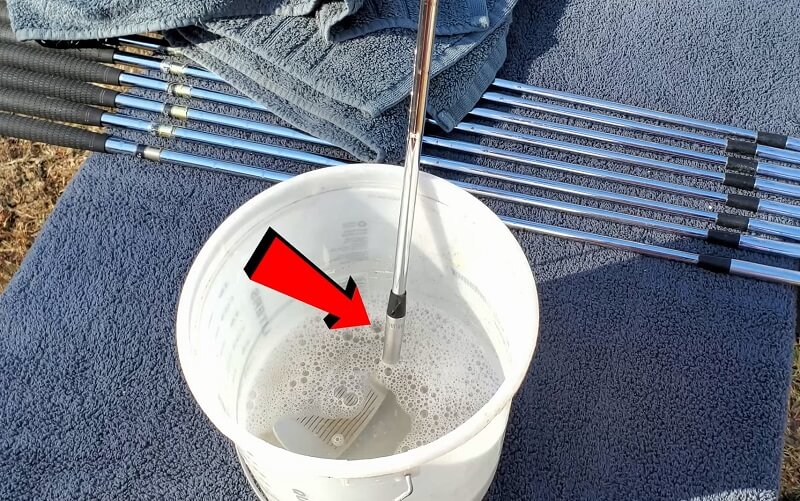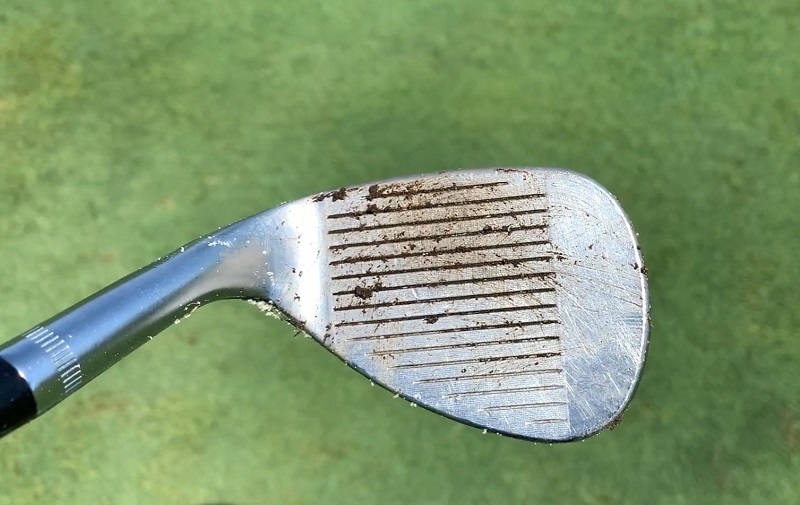Having clean golf clubs is essential for maximizing your performance on the golf course. Not only does it make a great impression when you pull out gleaming clubs for playing, but it can also help to improve accuracy and consistency during play because dirt and debris can affect the weight and overall alignment of the club head. With a few simple steps, keeping your golf clubs in tip-top condition doesn’t need to be difficult – let us guide you through how to clean them so properly they’ll stay looking their best year round!
Cleaning Golf Clubs Need To Prepare What?
Here are the essential items you should have on hand before cleaning your golf clubs:
- A soft brush: This can be a small scrub brush with soft bristles or even a toothbrush.
- A bucket of warm water: You’ll need this to make a soapy solution for cleaning the grips.
- Mild soap: Any mild dish soap or laundry detergent will do. Avoid using any abrasive cleaner, as this can damage the finish of your clubs.
- Clean cloths and towels: You’ll need these for drying and polishing after cleaning.
- Clubhead polish: This is not necessary but can help to restore a shiny finish to your clubface.
- Protective gloves: Wear gloves when using any cleaners or solvents for safety.
- Clubhead protectors: These are optional but can help to keep your clubs looking like new by protecting the clubface from dirt and debris.
How to Clean Golf Clubs
Here’s what you need to do:
- Start by using the soft brush to gently remove any dirt, mud, or grass clippings from the grooves on the clubface.
- Next, mix a small amount of mild soap with warm water in a bucket.
- Dip the soft cloth into the soapy solution, then wring it out.
- Wipe down the entire clubhead with the damp cloth, making sure to pay special attention to removing any dirt or debris from the grooves.
- Rinse off the soap with clean water, then dry the club head with a towel.
- If desired, apply a small amount of clubhead polish to the clubface and buff it in using a clean cloth.
- Finally, slip on the clubhead protectors and store your clubs in a safe place.

Golf club after cleaning
How To Clean Golf Club Grip
Cleaning golf club grips is a simple but important. There are different methods of cleaning grips, depending on the material they’re made from. Here are some tips to help you clean your golf club grips:
- Soft Grips: If your clubs feature soft rubber or synthetic leather grips, use a damp cloth to wipe them down. It’s important to make sure the cloth is only slightly wet and that you don’t over-soak the grip.
- Hard Grips: If your clubs have hard rubber or plastic grips, they can be cleaned using warm, soapy water and a soft brush. Make sure to scrub gently and be sure the soap doesn’t stay on the grip for too long.
- Leather Grips: If your grips are made of leather, use a damp cloth and leather cleaner to clean them. It’s best to avoid using any harsh cleaners or solvents as these can damage the leather.
If you want to give your grips a shiny finish, apply a small amount of grip wax. First, make sure the grip is clean and then use a soft cloth to rub the wax onto it. These simple steps should help keep your golf club grips clean and in good condition for years to come.
How To Clean Golf Club Shaft
If you want to keep your golf clubs in top condition, it’s important to clean the shafts as well as the grips. Here are some tips for keeping your golf club shafts looking like new:
- Cleaning Solution: Make a cleaning solution by combining two parts water with one part mild detergent (like dish soap). Use a soft cloth to wipe down the shafts with this solution and rinse them off with clean water.
- Drying: Once you’ve finished cleaning, make sure the shafts are dried thoroughly before stowing them away. You can use a clean towel to dry them or let air-dry overnight.
- Rust Prevention: To prevent rusting, apply a thin layer of shaft wax or silicon spray to the entire length of the club shafts. This will help protect them against moisture and dirt buildup.
Are Golf Clubs Rusting?
Golf clubs are vulnerable to rust due to their metal construction and exposure to moisture. This can reduce the lifespan of your club, as well as make them look unappealing and less aerodynamic. Here are some steps you can take to prevent your golf clubs from rusting:
- Clean your clubs regularly with a damp cloth and mild detergent. This will help remove any dirt, sweat or moisture accumulated on the clubs.
- Use a silicone-based spray to coat your clubs after each use and before storing them away. The protective layer created by the silicone helps to repel water and oxidation from affecting the clubs’ metal surface.
- Store your clubs in a dry place, such as a bag or cabinet, to reduce their exposure to moisture. Make sure they are completely dry before storing them away.
- If you notice rust starting to form on your clubs, remove it with a wire brush and polishing paste and then use the silicone-based spray to protect the club from further damage.
How To Clean Golf Clubs Rust
Begin by cleaning the club head and shaft with a soft, damp cloth to remove any dirt or debris.
Next, apply a rust-remover solution to the affected areas of the club using a small brush. Make sure to follow the product’s instructions and safety precautions carefully while doing this.

Cleaning Rust Golf Clubs
Once the solution has had time to work, use a wire brush to scrub away any remaining rust gently. Be sure to work in small circles and avoid pressing too hard on the metal surface of the club.
If still some stubborn areas of rust remain, apply an aluminum-oxide paste or fine-grit sandpaper to the affected areas and then polish with a brass brush.
Finally, apply a protective coating of silicone-based spray or wax to the club head and shaft to prevent further rust from forming in the future.
Common Mistakes When Cleaning Golf Clubs
Common mistakes when cleaning golf clubs can have unintended consequences, diminishing their performance on the course.
One common blunder is the use of abrasive materials or scrubbers, which can cause unsightly scratches and degrade the club’s surface.
Submerging the clubs in water is another frequent error that can lead to rust or other damage, especially in the hosel area where the clubhead and shaft meet.
It is important to avoid putting all the clubs in one bucket together, as wedges mixing with brand-new clubs can lead to undesirable outcomes.
It is advised not to lay wet grips out in the sun to dry, as excessive heat can cause them to deteriorate quickly. Furthermore, wet golf clubs should not be stored away after cleaning or after rain, as this can promote the development of rust.
How Often Should You Clean My Golf Club?
The frequency of cleaning your golf clubs should be determined by how much you play and the conditions in which you normally play. If you have been playing a lot or if the weather conditions have been particularly wet or humid, then you may need to clean them more frequently than normal.
Ideally, it is best to clean your clubs after each round of golf. This will ensure that dirt and debris are removed from the grooves and the face of your clubs, which can affect the performance of your golf shots. Use a clean towel to wipe down the heads, shafts and grips after each round.

Clean Your Club After Every Round
It is also important to have your clubs checked for wear and tear at least once a year by a qualified golf club professional. This should involve a full cleaning, inspection, and adjustment (if needed) of all your clubs to ensure they are still in good working order.
Finally, if you notice that your clubs are consistently losing performance or feel different after each round of play, then it may be time to consider having them professionally cleaned and adjusted. This can help restore your clubs’ performance and make sure you are still hitting the ball just as well as you did when they were new.
Related post:
- How To Store Golf Clubs Properly For Optimal Protection
- How Long Do Golf Clubs Last? Lifespan Of Golf Clubs
FAQs
Should Golf Clubs Be Cleaned After Each Use?
Golf clubs should be cleaned after each round of golf or practice session. This will help keep them in good condition and reduce the chances of dirt, debris, and moisture accumulating on the surface.
Can I Soak Golf Clubs In Vinegar?
Soaking golf clubs in a mixture of vinegar and water can help remove rust from the surface. However, it’s important to rinse the clubs off with clean water and dry them thoroughly before storing them away, as this will help prevent further rusting or corrosion.
Can I Clean The Golf Club With A Toothbrush?
You can clean your golf clubs with a toothbrush. This is especially helpful for getting into hard-to-reach areas between the grooves and around the shaft. Make sure to use a soft-bristled brush to not scratch or damage the club surface.
Can I Use Regular Soap to Clean Golf Clubs?
You can use regular soap to clean golf clubs. However, it’s important to thoroughly rinse the clubs afterward to avoid any residue that could damage the club’s finish or performance
Can I Use a Metal Brush to Clean Golf Clubs?
You can use a metal brush to clean golf clubs, but be careful not to damage the club’s finish or performance. It’s best to use a soft brush made of plastic or nylon so you don’t scratch the surface. Additionally, you should avoid scrubbing too hard and try to clean only areas that are visibly dirty. Finally, be sure to rinse the clubs afterward with a damp cloth or towel.
Final Thoughts
With these simple and easy to follow instructions, you can now ensure that your golf clubs are properly cleaned and maintained. This will help make sure your clubs stay in tip-top condition for longer, which is essential for any golfer who wants to make the most out of their game. Furthermore, cleaning golf clubs regularly can make a big difference in terms of accuracy.
The consistent use of regularly clean golf clubs will help to significantly improve your ball strike, trajectory, spin and overall distance accuracy. So take some time to give your golf equipment a good clean using the tips outlined in this blog post and you’ll be sure to reap the rewards quickly!

